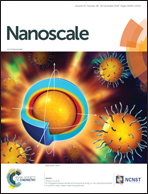Thermal insulation with 2D materials: liquid phase exfoliated vermiculite functional nanosheets†
Abstract
Phyllosilicates are layered materials possessing unique thermal properties, commonly exploited in their multilayered crystalline form as refractory insulators and heating elements. A more versatile use of such materials, however, would require their existence in the form of inks and dispersions ready to be patterned. Within this framework, the liquid-phase exfoliation of low-cost, low-purity materials such as bulk multiphasic minerals and powders represents an economically advantageous approach for the production of 2D nano-sized objects with a defined composition, size and morphology. Here, ultrasound-assisted exfoliation and shear-mixing of a multi-phasic vermiculite in mild acidic aqueous solutions were employed to successfully obtain dispersions of mono- and few-layer thick clay nanosheets. The exfoliated materials were thoroughly investigated through granulometry, X-Ray Diffraction (XRD), specific surface area measurements and AFM imaging. Despite the fact that the lateral size and the thickness distribution of exfoliated flakes obtained with the two approaches appear similar, the ultrasound-assisted exfoliation process yielded a larger amount of mono- and bi-layer thick flakes as well as materials with a higher specific surface area. XRD analysis revealed that the use of ultrasound waves in an acidic environment results in the complete exfoliation of the vermiculite layer, whereas the use of shear forces under the same conditions results in the exfoliation of hydrobiotite and mica crystalline phases. Thermal conductivity measurements provided clear evidence on how the structural changes – arising from the exfoliation process – have a direct impact on the properties of the exfoliated clay. Remarkably, compared to the raw material, the thermal conductivity of the exfoliated material decreases by 25%, reaching the ultra-low thermal conductivity regime (<0.1 W m−1 K−1). Our approach may enable in the future the generation of patterns of thermal insulators onto different surfaces by applying vermiculite nanosheets in the form of dispersions and printable inks.



 Please wait while we load your content...
Please wait while we load your content...